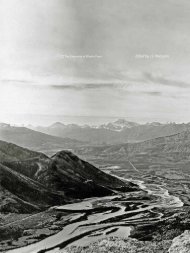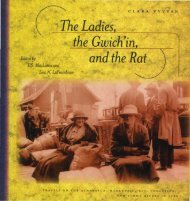Notes on Samuel Hearne's Journey from a Bibliographical Perspective
Notes on Samuel Hearne's Journey from a Bibliographical Perspective
Notes on Samuel Hearne's Journey from a Bibliographical Perspective
- No tags were found...
Create successful ePaper yourself
Turn your PDF publications into a flip-book with our unique Google optimized e-Paper software.
:2.8 Papers of the <strong>Bibliographical</strong> Society of Canada 3I /2, I2.9 MacLaren : <str<strong>on</strong>g>Notes</str<strong>on</strong>g> <strong>on</strong> <strong>Samuel</strong> <strong>Hearne's</strong> TourneyWest' as <strong>Hearne's</strong> route, other editi<strong>on</strong>s do not agree. In 1798, Dutchand Swedish translati<strong>on</strong>s appeared. According to the copies of thesetranslati<strong>on</strong>s made in 1982. for CIHM, Dutch readers encounteredHearne walking south west, 'zuidwesten';49 Swedish readers, however,found him ranging north west, 'Nordwast,'SO and he was stillheaded in that directi<strong>on</strong> a year later when met by French readers'Nord-Ouest.'!' In fact, as late as four years later, when the Americanabridgement appeared, Hearne was headed 'north west.'S) Butthe most original resoluti<strong>on</strong> was offered in the first translati<strong>on</strong>,published in German in 1797 and with notes, a year before his death,. by Johann Reinhold Forster, whose work would produce the Dutchtranslati<strong>on</strong> the next year. In the German translati<strong>on</strong>, Hearne doesnot set off in <strong>on</strong>e or the other directi<strong>on</strong> towards Point Lake; hesimply goes farther: '... und am folgenden Morgen gingen wirweiter .'B Whether or not Forster, the distinguished scholar andnaturalist aboard Cook's sec<strong>on</strong>d voyage to the Pacific, observed thatthe L<strong>on</strong>d<strong>on</strong> and Dublin editi<strong>on</strong>s disagreed and c<strong>on</strong>sulted the translator<strong>on</strong> the matter (if he did not himself serve in that capacity) isuncertain; what is certain is that a recent German translati<strong>on</strong>, andthe most recent editi<strong>on</strong> in any language, faithfully follows Forsterfarther : '... und am folgenden Tag gingen wir weiter.'s4 "German inventiveness, however, appears to have been matched ina very popular facsimile reprint of the first editi<strong>on</strong>, k~own w.id~lyas the Hurtig reprint.t! This was, however, not the first facsunilereprint of the first editi<strong>on</strong>. That was the Da Capo facsimile, whichwas published in I968. S6 In it, all the signatures appear as they arein the copies of the first editi<strong>on</strong> examined. Also in it, <strong>Hearne's</strong>directi<strong>on</strong> <strong>on</strong> 8 September 1771 is 'North West' at page 2.02., and thelist of errata appears where <strong>on</strong>e expects it, <strong>on</strong> the verso of leaf B4.On the other hand, the Hurtig facsimile reprint, made three yearslater, is not identical. Like Da Capo's facsimile, it is a photographic,not a typographic [i.e.re-typeset], facsimile. It too has 'North' ~s thecatchword <strong>on</strong> page 2.01, but 'South' [i.e, 'South West, by the SIdeofPoint Lake') as the first word of page 2.02., a c<strong>on</strong>fusi<strong>on</strong> perhapssuitably met<strong>on</strong>ymic of <strong>Hearne's</strong> trek but hardly enlightening. Thecopy <strong>from</strong> which the facsimile was made has not been locat~d andperhaps it does not exist. Mr. Hurtig remembers cl~ar~y that ~s ownpers<strong>on</strong>al copy was used for the making of the facsimile repnnt, buthis, by agreeing with all other copies of .th~ first e~ti?n that havebeen examined , disagrees with the facsimile repnnt 10 respect of'North West.'57 As well, his copy possesses both the page of erra~aand signatures at the bottom of pages, neither of which appear 10, !j ,t~e HUrtig facsimile . The Canadian editi<strong>on</strong> also has printed correcti<strong>on</strong>sof the oth~r four ~rrata list~d <strong>on</strong> the first editi<strong>on</strong> 's errata page,~nd perhaps this explams why It does not reprint the errata page~tself'.I~y it n~where includes the map of <strong>Hearne's</strong> route, which18 p~sl~l<strong>on</strong>ed f~c1O~ the title page in the first editi<strong>on</strong> and in the firstfacsimile repnnt,IS another questl<strong>on</strong>.] In order to accommodate~.H. N~atby'~ n~w introducti<strong>on</strong>, <strong>on</strong>e further change was introducedmto this facsimile reprint [suddenly, a loaded term): all pages withr?~n numer~ ha~e been renumbered in a modem Bembo typesimilar but not Identical to that of the first editi<strong>on</strong>. Indeed because~e word 'South' seems slightly <strong>on</strong> an angle to the rest o£the firstline of page 2.02. and because no copy of the first editi<strong>on</strong> has yetsurfac~d which bears the change to 'South' in the type itself, <strong>on</strong>em~st infer, at least until further evidence surfaces, that Hurtig'spnnter [Charles E.Tuttle Company, of Rutland, Verm<strong>on</strong>t) used type~at matched the Bembo type in which the first editi<strong>on</strong> was set and1Ocorporated into Hurtig's facsimile reprint the changes o~ theerrata pa~e of the first editi<strong>on</strong>. This amounts <strong>on</strong>ly to unc<strong>on</strong>firmablespeculatlOn, for corresp<strong>on</strong>dence with the Tuttle firm has yielded noeditorial f~e for ~s work, Tuttle no l<strong>on</strong>ger employs any<strong>on</strong>e whoworked WIth the firm when the facsimile reprint was made and~harles Tuttle himself, the president at the time, is prevented byillness <strong>from</strong> looking further into the questi<strong>on</strong>. 58.In the abs~nce of supporting evidence, the usual test of diag<strong>on</strong>allinear collati<strong>on</strong> was made, setting a straight rule diag<strong>on</strong>ally acrossthe same page 12.02.)in various copies of the first editi<strong>on</strong> in order todiscover if the line passes through the same letters at the samepoints. In this particular case, the rule was set twice, <strong>from</strong> the firstword and, because it is the questi<strong>on</strong>able <strong>on</strong>e, <strong>from</strong> the sec<strong>on</strong>d word~o~ to the left edge of the last letter in the last row. The resultsindicate nothing d~fin!tive, for ~though there is a slight discrepancybetween the line 10 the Hurtig reprint's 'South' and the line inother copies of t~e first editi<strong>on</strong>, there are also slight discrepanciesam<strong>on</strong>g those copies themselves - no Surprise given the comm<strong>on</strong>occurrence of type shifting.Regrettably, neither has any written informati<strong>on</strong> survived in thefile~ of.Hurt~ Publi~hers c<strong>on</strong>cerning the copy'used for the Hurtigfacsimile reprint. This leaves <strong>on</strong>e in the perplexity of an unsatisfactoril!tentative c<strong>on</strong>clusi<strong>on</strong>: in the case of the 8 September InIporti<strong>on</strong> of <strong>Hearne's</strong> route , the Hurtig facsimile reprint is not afacsimile reprint of the first quarto editi<strong>on</strong> . It may be that eightythreecopies, randomly acquired and located at present across a wide
















